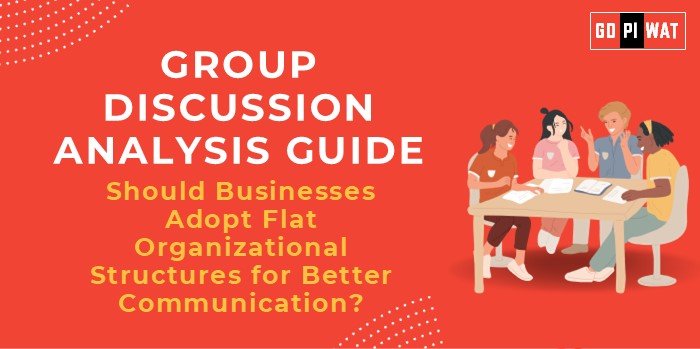📋 Group Discussion (GD) Analysis Guide
🌐 Topic: Should Businesses Adopt Flat Organizational Structures for Better Communication?
📖 Introduction to the Topic
Opening Context: In today’s dynamic business environment, traditional hierarchical organizations face challenges like delayed decision-making and communication silos. Flat organizational structures, which emphasize fewer managerial layers, are emerging as an alternative to foster better collaboration and faster communication.
Topic Background: Flat structures aim to minimize bureaucracy, empower employees, and encourage direct communication across all levels. Companies like Tesla and Spotify have successfully experimented with such structures. However, scalability and coordination remain key concerns.
📊 Quick Facts and Key Statistics
- 📉 Communication Breakdown: 86% of employees cite poor communication as a major organizational problem (Forbes, 2024).
- 💡 Employee Engagement: Flat organizations report a 20% higher engagement rate due to transparency (Gallup, 2023).
- 🚀 Innovation: Decentralized companies are 30% more innovative in decision-making (Deloitte Report, 2024).
- 📏 Scalability Issues: Only 15% of Fortune 500 companies employ flat structures due to operational complexities.
👥 Stakeholders and Their Roles
- Top Management: Ensures organizational goals are met while implementing flexible communication.
- Employees: Benefit from greater autonomy but require accountability.
- Middle Managers: Role may diminish, leading to resistance or redefinition.
- Customers: Indirect stakeholders benefiting from faster decision-making and improved service delivery.
🏆 Achievements and Challenges
✨ Achievements
- Improved Communication: Direct collaboration speeds up decisions.
- Increased Employee Empowerment: Roles are more flexible and dynamic.
- Cost Efficiency: Reduction of unnecessary managerial overhead.
⚠️ Challenges
- Scalability Issues: Difficult to implement in large, multinational organizations.
- Accountability Gaps: Lack of clarity in leadership can cause confusion.
- Resistance to Change: Middle managers may oppose structural changes.
🌍 Global Comparisons
- 🎧 Spotify: A successful model of “squads” and team autonomy.
- 👟 Zappos: Transitioned to holacracy but faced mixed results due to coordination issues.
- 🚘 Tesla: Flat structure enables Elon Musk to oversee multiple departments effectively.
📑 Structured Arguments for Discussion
- Supporting Stance: “Flat organizational structures promote open communication, reduce hierarchy, and enable agile decision-making in fast-paced industries like tech and startups.”
- Opposing Stance: “Flat organizations lack clear leadership lines, making them unsuitable for complex, large-scale businesses.”
- Balanced Perspective: “While flat structures encourage collaboration and innovation, their effectiveness depends on company size, culture, and operational needs.”
🗣️ Effective Discussion Approaches
- Opening Approaches:
- 📊 Data-Driven: “Companies with flat structures experience 20% higher innovation rates and faster decision-making cycles.”
- 📋 Case Study: “Spotify’s squad model showcases how decentralized teams can deliver outstanding results.”
- Counter-Argument Handling:
- Scalability Concern: “Flat structures can evolve into hybrid models to balance flexibility and coordination in large businesses.”
📈 Strategic Analysis of Strengths and Weaknesses
- Strengths: Faster decision-making, employee empowerment, cost efficiency.
- Weaknesses: Lack of accountability, scalability limitations.
- Opportunities: Suitable for startups and tech firms, encourages innovation and creativity.
- Threats: Resistance to change, ambiguity in leadership roles.
🎓 Connecting with B-School Applications
- Real-World Applications:
- Team-Based Learning: Encourages collaborative project management.
- Innovation Strategy: Highlights agile practices for product development.
- Sample Interview Questions:
- “Do you think flat organizational structures can succeed in traditional industries like manufacturing?”
- “How can companies balance flat structures and accountability?”
- Insights for B-School Students:
- Explore hybrid structures combining agility and accountability.
- Analyze case studies like Spotify and Zappos for practical insights.


